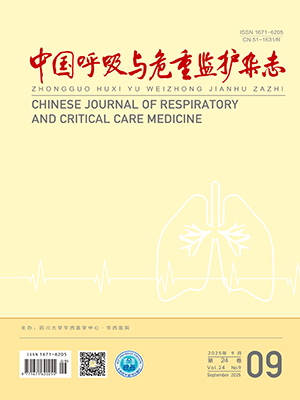Objectives To investigate the pathogenic characteristics and the possible relationship between pathogen and respiratory function in patients with acute exacerbations of COPD (AECOPD).Methods Sixty-four patients with AECOPD were investigated with lung function test,quantitative and qualitative sputum bacteria culture,drug sensitive test,and Mycoplasma pneumoniae and Chlamydia pneumoniae specific antibodies test.The patients were divided into three groups according to FEV1%pred,50%≤FEV1 lt;80%pred for the Group One,30%pred≤FEV1 lt;50%pred for the Group Two,and FEV1 lt;30%pred for the Group Three.Meanwhile according to the result of sputum culture,infective bacteria were divided into four kinds: Gram-positive cocci for kind A,Gram-negtive germ except kind C for kind B,Acinetobacter,Enterobacter and Pseudomonas spp for kind C,and negative result for kind D.Results ⑴Of 64 patients who were conducted quantitative sputum culture,germs isolated were mostly Streptococcus pneumoniae,Enterobacter,Moraxella Catarrhalis,and Pseudomonas.Of 38 patients who were conducted qualitative sputum culture,most of them were found mixed infection,and germs isolated were mostly Streptococcus pneumoniae,Staphylococcus epidermidis,Acinetobacter and Enterobacter.⑵Both quantitative and qualitative sputum culture revealed that Most of Group One patients were not infected by bacteria,and the Group Three patients were mainly by resistant kind A and kind C bacteria (P lt;0.01 and 0.05 respectively).⑶The infection of Mycoplasma pneumoniae or Chlamydia pneumoniae was identified in 29.4% of the cases.Conclusions There is a close correlation between the degree of functional damage and the infected bacterial strains for patients with AECOPD,the more chance of bacteria infection such as S pneumoniae,Acinetobacter,Enterobacter and Pseudomonas,the more damage of lung function.
Citation: XU jianying,LI xiaoyan,DU yongcheng,YANG Lili,WANG Shufeng,WANG hong. Relationship between pathogen and lung function in patients with acute exacerbations of COPD. Chinese Journal of Respiratory and Critical Care Medicine, 2007, 6(2): 88-93. doi: Copy
Copyright © the editorial department of Chinese Journal of Respiratory and Critical Care Medicine of West China Medical Publisher. All rights reserved




